Redistributing Phosphorus in Animal Manure from a Livestock-Intensive Region to an Arable Region: Exploration of Environmental Consequences
Abstract
:1. Introduction
2. Materials and Methods
2.1. LCA Approach and Functional Unit
2.2. Geographical Scope and Technology Choice
2.3. Scenarios
| Ref: | Reference scenario. Manure stored in house in a manure cellar and applied locally to grassland on the donor animal farm. |
| SP: | In-house pre-stored slurry separated by screw press (SP). The resulting solid fraction is stored, hygienized, and transported to a recipient farm in Akershus county and applied to arable land. Liquid fraction stored and applied locally. |
| DC: | As the SP scenario, but separation by decanter centrifuge (DC). |
| AD_SP: | In-house pre-stored slurry digested through anaerobic digestion (AD), then separated by screw press (SP). The digested solid fraction is stored, hygienized, and transported to Akershus county and applied to arable land. Digested liquid fraction stored and applied locally. |
| AD_DC: | As the AD_SP press scenario, but separation by decanter centrifuge (DC). |
| NoSep: | No separation of slurry. Slurry stored as in the reference scenario, then hygienized and transported in its entirety to Akershus county and applied on arable land. |
2.4. System Boundary
2.5. Life Cycle Data Inventory and Assumptions
2.5.1. Manure Characteristics
2.5.2. In-House Storage
2.5.3. Processing
2.5.4. End-Product Storage
2.5.5. Transport
2.5.6. Field Application
2.5.7. Manure Fertilizer Value and Mineral Fertilizer Substitution
2.6. Impact Assessment
2.7. The Effect of Regional Differences
2.8. Sensitivity Analysis
3. Results
3.1. Impact Assessment Results
3.2. Isolation of the Effect of Regional Differences
3.3. Sensitivity Analysis
3.3.1. Perturbation Analysis
3.3.2. Scenario Analysis of Basis for Fertilizer Application on Arable Land
3.3.3. Scenario Analysis of Soil P Level
3.3.4. Scenario Analysis of Transport Distance and Mode
4. Discussion
4.1. The Environmental Impact of Manure P Redistribution
4.2. The Influence of Regional Characteristics and Transport
4.3. Assumptions for Mineral Fertilizer Substitution
4.4. Parameter Uncertainties
4.5. The Studied Case and the European Perspective
4.6. Limitations and Further Research
5. Conclusions
Supplementary Materials
Acknowledgments
Author Contributions
Conflicts of Interest
References
- Cordell, D.; Drangert, J.-O.; White, S. The story of phosphorus: Global food security and food for thought. Glob. Environ. Chang. 2009, 19, 292–305. [Google Scholar] [CrossRef]
- Sharpley, A.N.; Bergström, L.; Aronsson, H.; Bechmann, M.; Bolster, C.H.; Börling, K.; Djodjic, F.; Jarvie, H.P.; Schoumans, O.F.; Stamm, C.; et al. Future agriculture with minimized phosphorus losses to waters: Research needs and direction. AMBIO 2015, 44, 163–179. [Google Scholar] [CrossRef] [PubMed]
- Ashley, K.; Cordell, D.; Mavinic, D. A brief history of phosphorus: From the philosopher’s stone to nutrient recovery and reuse. Chemosphere 2011, 84, 737–746. [Google Scholar] [CrossRef] [PubMed]
- Maguire, R.O.; Chardon, W.; Simard, R.R. Assessing potential environmental impacts of soil phosphorus by soil testing. In Phosphorus: Agriculture and the Environment; Sims, J.T., Sharpley, A.N., Eds.; ASA: Madison, WI, USA, 2005; pp. 145–180. [Google Scholar]
- Senthilkumar, K.; Nesme, T.; Mollier, A.; Pellerin, S. Regional-scale phosphorus flows and budgets within france: The importance of agricultural production systems. Nutr. Cycl. Agroecosyst. 2012, 92, 145–159. [Google Scholar] [CrossRef]
- Bateman, A.; van der Horst, D.; Boardman, D.; Kansal, A.; Carliell-Marquet, C. Closing the phosphorus loop in england: The spatio-temporal balance of phosphorus capture from manure versus crop demand for fertiliser. Resour. Conserv. Recycl. 2011, 55, 1146–1153. [Google Scholar] [CrossRef]
- Hanserud, O.S.; Brod, E.; Øgaard, A.F.; Mueller, D.; Brattebø, H. A multi-regional soil phosphorus balance for exploring secondary fertilizer potential: The case of norway. Nutr. Cycl. Agroecosyst. 2016, 104, 307–320. [Google Scholar] [CrossRef]
- Tóth, G.; Guicharnaud, R.-A.; Tóth, B.; Hermann, T. Phosphorus levels in croplands of the european union with implications for p fertilizer use. Eur. J. Agron. 2014, 55, 42–52. [Google Scholar] [CrossRef]
- Chowdhury, R.B.; Chakraborty, P. Magnitude of anthropogenic phosphorus storage in the agricultural production and the waste management systems at the regional and country scales. Environ. Sci. Pollut. Res. 2016, 23, 15929–15940. [Google Scholar] [CrossRef] [PubMed]
- Chen, M.; Graedel, T.E. A half-century of global phosphorus flows, stocks, production, consumption, recycling, and environmental impacts. Glob. Environ. Chang. 2016, 36, 139–152. [Google Scholar] [CrossRef]
- Withers, P.J.A.; van Dijk, K.C.; Neset, T.S.S.; Nesme, T.; Oenema, O.; Rubæk, G.H.; Schoumans, O.F.; Smit, B.; Pellerin, S. Stewardship to tackle global phosphorus inefficiency: The case of europe. AMBIO 2015, 44 (Suppl. S2), 193–206. [Google Scholar] [CrossRef] [PubMed]
- Klinglmair, M.; Lemming, C.; Jensen, L.S.; Rechberger, H.; Astrup, T.F.; Scheutz, C. Phosphorus in denmark: National and regional anthropogenic flows. Resour. Conserv. Recycl. 2015, 105, 311–324. [Google Scholar] [CrossRef]
- De Vries, J.W.; Hoogmoed, W.B.; Groenestein, C.M.; Schröder, J.J.; Sukkel, W.; De Boer, I.J.M.; Groot Koerkamp, P.W.G. Integrated manure management to reduce environmental impact: I. Structured design of strategies. Agric. Syst. 2015, 139, 29–37. [Google Scholar] [CrossRef]
- Sandars, D.L.; Audsley, E.; Cañete, C.; Cumby, T.R.; Scotford, I.M.; Williams, A.G. Environmental benefits of livestock manure management practices and technology by life cycle assessment. Biosyst. Eng. 2003, 84, 267–281. [Google Scholar] [CrossRef]
- Brockmann, D.; Hanhoun, M.; Négri, O.; Hélias, A. Environmental assessment of nutrient recycling from biological pig slurry treatment—Impact of fertilizer substitution and field emissions. Bioresour. Technol. 2014, 163, 270–279. [Google Scholar] [CrossRef] [PubMed]
- De Vries, J.W.; Groenestein, C.M.; De Boer, I.J.M. Environmental consequences of processing manure to produce mineral fertilizer and bio-energy. J. Environ. Manag. 2012, 102, 173–183. [Google Scholar] [CrossRef] [PubMed]
- ten Hoeve, M.; Hutchings, N.J.; Peters, G.M.; Svanström, M.; Jensen, L.S.; Bruun, S. Life cycle assessment of pig slurry treatment technologies for nutrient redistribution in denmark. J. Environ. Manag. 2014, 132, 60–70. [Google Scholar] [CrossRef] [PubMed]
- Notarnicola, B.; Sala, S.; Anton, A.; McLaren, S.J.; Saouter, E.; Sonesson, U. The role of life cycle assessment in supporting sustainable agri-food systems: A review of the challenges. J. Clean. Prod. 2017, 140, 399–409. [Google Scholar] [CrossRef]
- International organization of standardization (ISO). ISO 14040:2006(e) Environmental Management—Life Cycle Assessment—Principles and Framework; ISO: Geneva, Switzerland, 2006; p. 20. [Google Scholar]
- International organization of standardization (ISO). ISO 14044:2006(e) Environmental Management—Life Cycle Assessment—Requirements and Guidelines; ISO: Geneva, Switzerland, 2006; p. 46. [Google Scholar]
- European Commission JRC. International Reference Life Cycle Data System (ILCD) Handbook—General Guide for Life Cycle Assessment—Provisions and Action Steps, 1st ed.; European Commission, Joint Research Centre, Institute for Enviroment and Sustainability: Luxembourg, 2010. [Google Scholar]
- Cherubini, F.; Strømman, A.H. Life cycle assessment of bioenergy systems: State of the art and future challenges. Bioresour. Technol. 2011, 102, 437–451. [Google Scholar] [CrossRef] [PubMed]
- Liu, Y.; Villalba, G.; Ayres, R.U.; Schroder, H. Global phosphorus flows and environmental impacts from a consumption perspective. J. Ind. Ecol. 2008, 12, 229–247. [Google Scholar] [CrossRef]
- Hjorth, M.; Christensen, K.V.; Christensen, M.L.; Sommer, S.G. Solid-liquid separation of animal slurry in theory and practice. A review. Agron. Sustain. Dev. 2010, 30, 153–180. [Google Scholar] [CrossRef]
- Norwegian Ministry of Agriculture and Food. St.Meld. Nr. 39 (2008–2009). Klimautfordringene—Landbruket en del av løsningen. (norwegian white paper); Norwegian Ministry of Agriculture and Food: Oslo, Norway, 2009.
- Bechmann, M. The effect of phosphorus application and balance on concentrations in streams from agricultural dominated catchments in norway. Acta Agric. Scand. Sect. B Soil Plant Sci. 2014, 63, 162–171. [Google Scholar] [CrossRef]
- NIBIO. Gjødslingshåndbok (Norwegian Fertilizer Handbook). Available online: http://www.bioforsk.no/gjodslingshandbok (accessed on 20 October 2015).
- Øgaard, A.F. Gjødslingspraksis Ved Bruk av Husdyrgjødsel. Resultater Fra Fire Nedbørsfelt i Jova-Programmet; Bioforsk Report Vol. 3 No. 60; Bioforsk: Tingvoll, Norway, 2008; p. 21. [Google Scholar]
- Brogaard, L.K.; Petersen, P.H.; Nielsen, P.D.; Christensen, T.H. Quantifying capital goods for biological treatment of organic waste. Waste Manag. Res. 2015, 33, 96–106. [Google Scholar] [CrossRef] [PubMed]
- Mezzullo, W.G.; McManus, M.C.; Hammond, G.P. Life cycle assessment of a small-scale anaerobic digestion plant from cattle waste. Appl. Energy 2013, 102, 657–664. [Google Scholar] [CrossRef]
- The Norwegian Regulations Relating to Organic Fertiliser. For-2003-07-04-951. Published in 2003, Folder No. 11. Available online: https://lovdata.no/dokument/SF/forskrift/2003-07-04-951 (accessed on 1 December 2013).
- Fylkesmannen i Rogaland. Samspel Mellom Biogass og Naturgass i Felles Røyrnett (Interactions between Biogas and Natural Gas in a Common Piping Network). Available online: https://www.regjeringen.no/no/aktuelt/fylkesnytt-fra-rogaland-12015/id2397288/ (accessed on 4 March 2015).
- Wernet, G.; Bauer, C.; Steubing, B.; Reinhard, J.; Moreno-Ruiz, E.; Weidema, B. The ecoinvent database version 3 (part i): Overview and methodology. Int. J. Life Cycle Assess. 2016, 21, 1218–1230. [Google Scholar] [CrossRef]
- Nesheim, L.; Sikkeland, E.H. Mengd Utskilt Husdyrgjødsel—Forslag til Nye Standardtal; Norwegian Institute for Agricultural and Environmental Research: Kvithamar, Norway, 2013; p. 20. [Google Scholar]
- Morken, J.; Ayoub, S.; Sapci, Z. Revision of the Norwegian Model for Estimating Methane Emission from Manure Mangement; Institutt for Matematiske Realfag og Teknologi, Universitetet for Miljø-og Biovitenskap: Ås, Norway, 2013. [Google Scholar]
- Daugstad, K.; Kristoffersen, A.Ø.; Nesheim, L. Næringsinnhald i Husdyrgjødsel. Analyser av Husdyrgjødsel Frå Storfe, Sau, Svin og Fjørfe 2006–2011; Bioforsk Report Vol. 7 No. 24; Bioforsk: Tingvoll, Norway, 2012; p. 29. [Google Scholar]
- Bergslid, I.K.; Solemdal, L. Husdyrgjødsel og Lagerkapasitet; Bioforsk Tema No.1; Bioforsk: Tingvoll, Norway, 2014. [Google Scholar]
- Sandmo, T. The Norwegian Emission Iventory 2014; Documents 2014/35; Statistics Norway: Oslo, Norway, 2014. [Google Scholar]
- IPCC. Emissions from livestock and manure management. In 2006 IPCC Guidelines for National Greenhouse Gas Inventories, Prepared by the National Greenhouse Gas Inventories Programme; Vol. 4 Agriculture, Forestry and other Land Use; Eggleston, S., Buendia, L., Miwa, K., Ngara, T., Tanabe, K., Eds.; IGES: Kanagawa, Japan, 2006. [Google Scholar]
- Wesnæs, M.; Wenzel, H.; Petersen, B.M. Life Cycle Assessment of Slurry Management Technologies; University of Southern Denmark and Department of Agroecology and Environment, Aarhus University Denmark: Aarhus, Denmark, 2009; p. 266. [Google Scholar]
- Morken, J.; Linjordet, R.; Bøen, A. Norwegian ammonia emissions—Present state and perspective. In Emissions from European Agriculture; Kuczynski, T., Dämmgen, U., Webb, J., Myczko, A., Eds.; Wageningen Academic Publishers: Wageningen, The Netherlands, 2005; pp. 181–191. [Google Scholar]
- IPCC. Good Practice Guidance and Uncertainty Management in National Greenhouse Gas Inventories, Chapter 4 Agriculture; Intergovernmental Panel on Climate Change: Geneva, Switzerland, 2000. [Google Scholar]
- Hansen, M.N.; Sommer, S.G.; Hutchings, N.J.; Sørensen, P. Emission FACTORs for Calculation of Ammonia Volatilization by Storage and Application of Animal Manure, Djf Husdyrbrug nr.84; Det Jordbrugsvidenskabelige Fakultet, Aarhus Universitet: Aarhus, Denmark, 2008. [Google Scholar]
- Sommer, S.G.; Petersen, S.O.; Møller, H.B. Algorithms for calculating methane and nitrous oxide emissions from manure management. Nutr. Cycl. Agroecosyst. 2004, 69, 143–154. [Google Scholar] [CrossRef]
- Morken, J.; Nesheim, L. Utnytting og tap av næringsstoff i husdyrgjødsel—Framtidige utfordringar (utilization and loss of nutrients in manure—Future challenges). Grønn Kunnskap 2004, 8, 51–61. [Google Scholar]
- Bechmann, M. Long-term monitoring of nitrogen in surface and subsurface runoff from small agricultural dominated catchments in Norway. Agric. Ecosyst. Environ. 2014, 198, 13–24. [Google Scholar] [CrossRef]
- Bechmann, M.; Greipsland, I.; Riley, H.; Eggestad, H.O. Nitrogen Losses from Agricultural Areas. A Fraction of Applied Fertilizer and Manure (Fracleach); Bioforsk Report Vol. 7 No. 50; Bioforsk: Tingvoll, Norway, 2012. [Google Scholar]
- Lyng, K.-A.; Modahl, I.S.; Møller, H.; Morken, J.; Briseid, T.; Hanssen, O.J. The biovaluechain model: A norwegian model for calculating environmental impacts of biogas value chains. Int. J. Life Cycle Assess. 2015, 20, 490–502. [Google Scholar] [CrossRef]
- Morken, J.; Norwegian University of Life Sciences, Aas, Norway. Personal communication, 2015.
- Arnøy, S.; Lyng, K.-A.; Modahl, I.S.; Baxter, J.; Bakke, R.; Hovland, J. Utilisation of Farm Manure for Biogas PRODUction. Environmental and Economic Analysis of Local and Central Biogas Plants, Including Pipeline Transport of Biogas; Or.06.14; Østfoldforskning: Kråkerøy, Norway, 2014. [Google Scholar]
- Melse, R.W.; De Buisonjé, F.E.; Verdoes, N.; Willers, H.C. Quick Scan Van Be-en Verwerkingstechnieken voor Dierlijke Mest; Animal Sciences Group: Lelystad, The Netherlands, 2004. [Google Scholar]
- Møller, H.B.; Sommer, S.G.; Ahring, B.K. Separation efficiency and particle size distribution in relation to manure type and storage conditions. Bioresour. Technol. 2002, 85, 189–196. [Google Scholar] [CrossRef]
- IPCC. N2O emissions from managed soils, and CO2 emissions from lime and urea application. In 2006 IPCC Guidelines for National Greenhouse Gas Inventories; Prepared by the National Greenhouse Gas Inventories Programme, Vol. 4 Agriculture, Forestry and other Land Use; Eggleston, S., Buendia, L., Miwa, K., Ngara, T., Tanabe, K., Eds.; IGES: Kanagawa, Japan, 2006. [Google Scholar]
- Krogstad, T.; Øgaard, A.F.; Kristoffersen, A.Ø. New p recommendations for grass and cereals in Norwegian agriculture. Nord. Assoc. Agric. Sci. (NJF) Rep. 2008, 4, 42–46. [Google Scholar]
- Egnér, H.; Riehm, H.; Domingo, W.R. Untersuchungen über die chemische boden-analyse als grundlage für die beurteilung des nährstoffzustandes der boden. Kungliga Lantbrukshögskolans Annaler 1960, 26, 199–215. [Google Scholar]
- Brod, E.; Øgaard, A.F.; Haraldsen, T.K.; Krogstad, T. Waste products as alternative phosphorus fertilisers part ii: Predicting p fertilisation effects by chemical extraction. Nutr. Cycl. Agroecosyst. 2015, 103, 187–199. [Google Scholar] [CrossRef]
- Goedkoop, M.; Heijungs, R.; Huijbregts, M.; De Schryver, A.; Struijs, J.; van Zelm, R. Recipe 2008, a Life Cycle Impact Assessment Method Which Comprises Harmonised Category Indicators at the Midpoint and the Endpoint Level, 1st ed.; Report 1: Characterisation; Ministry of Housing, Spatial Planning and Environment: The Hague, The Netherlands, 2009. [Google Scholar]
- Clavreul, J.; Guyonnet, D.; Christensen, T.H. Quantifying uncertainty in lca-modelling of waste management systems. Waste Manag. 2012, 32, 2482–2495. [Google Scholar] [CrossRef] [PubMed]
- Amon, B.; Kryvoruchko, V.; Amon, T.; Zechmeister-Boltenstern, S. Methane, nitrous oxide and ammonia emissions during storage and after application of dairy cattle slurry and influence of slurry treatment. Agric. Ecosyst. Environ. 2006, 112, 153–162. [Google Scholar] [CrossRef]
- Wood, S.; Cowie, A. A Review of Greenhouse Gas Emission Factors for Fertiliser Production. For Iea Bioenergy Task 38; Research and Development Division, State Forests of New South Wales, Cooperative Research Centre for Greenhouse Accounting: Canberra, Australia, 2004; p. 20. [Google Scholar]
- Refsgaard, K.; Bergsdal, H.; Pettersen, J.; Berglann, H. Climate Gas Emissions from Food Systems—Use of Lca Analyses; Norwegian Agricultural Economics Research Institute: Oslo, Norway, 2011; p. 25. [Google Scholar]
- Rodhe, L.; Ascue, J.; Nordberg, Å. Emissions of greenhouse gases (methane and nitrous oxide) from cattle slurry storage in northern europe. IOP Conf. Ser. Earth Environ. Sci. 2009, 8, 18. [Google Scholar] [CrossRef]
- Dinuccio, E.; Berg, W.; Balsari, P. Gaseous emissions from the storage of untreated slurries and the fractions obtained after mechanical separation. Atmos. Environ. 2008, 42, 2448–2459. [Google Scholar] [CrossRef]
- Van Dijk, K.C.; Lesschen, J.P.; Oenema, O. Phosphorus flows and balances of the European union member states. Sci. Total Environ. 2016, 542, 1078–1093. [Google Scholar] [CrossRef] [PubMed]
- FAO. The State of Food and Agriculture. Livestock in the Balance; Food and Agriculture Organization of the United Nations: Rome, Italy, 2009; p. 180. [Google Scholar]
- Willeghems, G.; De Clercq, L.; Michels, E.; Meers, E.; Buysse, J. Can spatial reallocation of livestock reduce the impact of ghg emissions? Agric. Syst. 2016, 149, 11–19. [Google Scholar] [CrossRef]

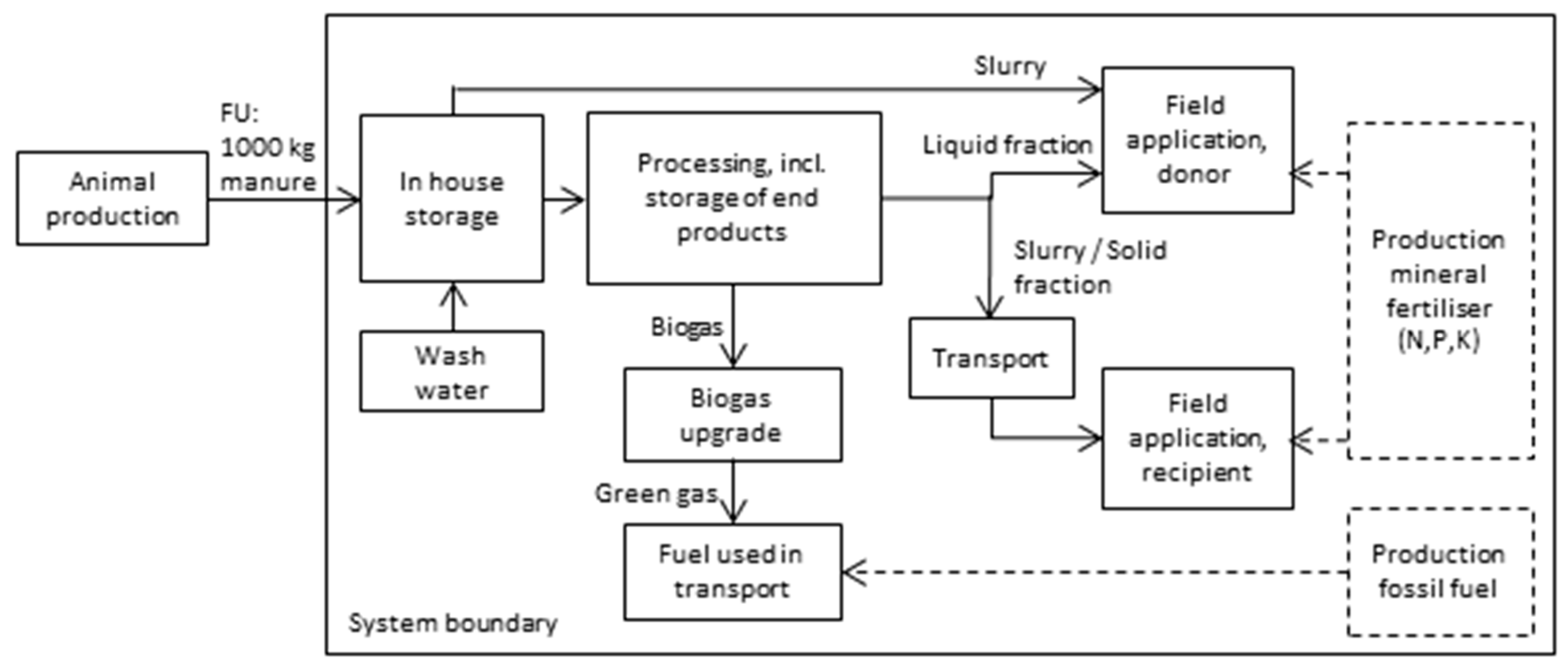
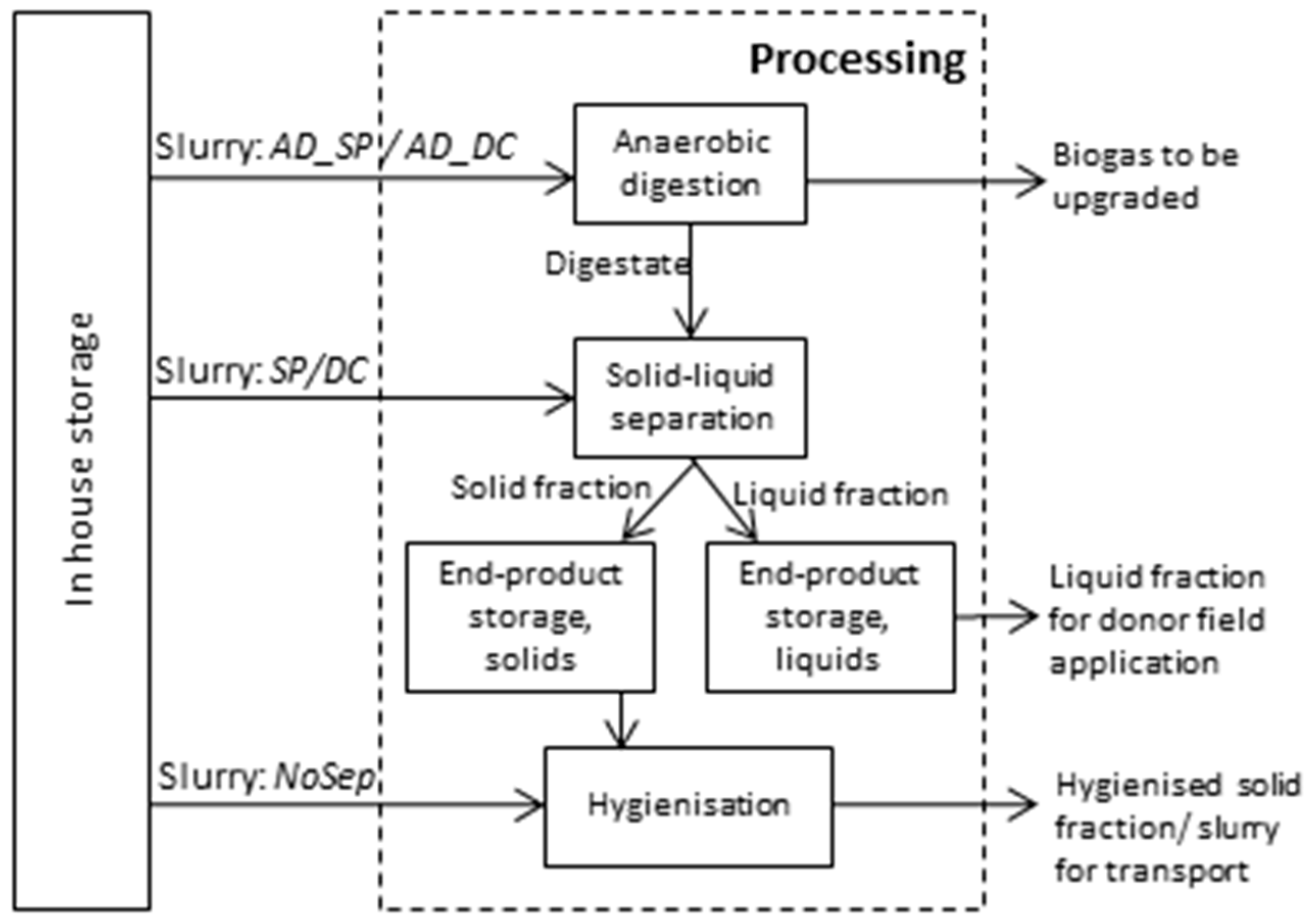
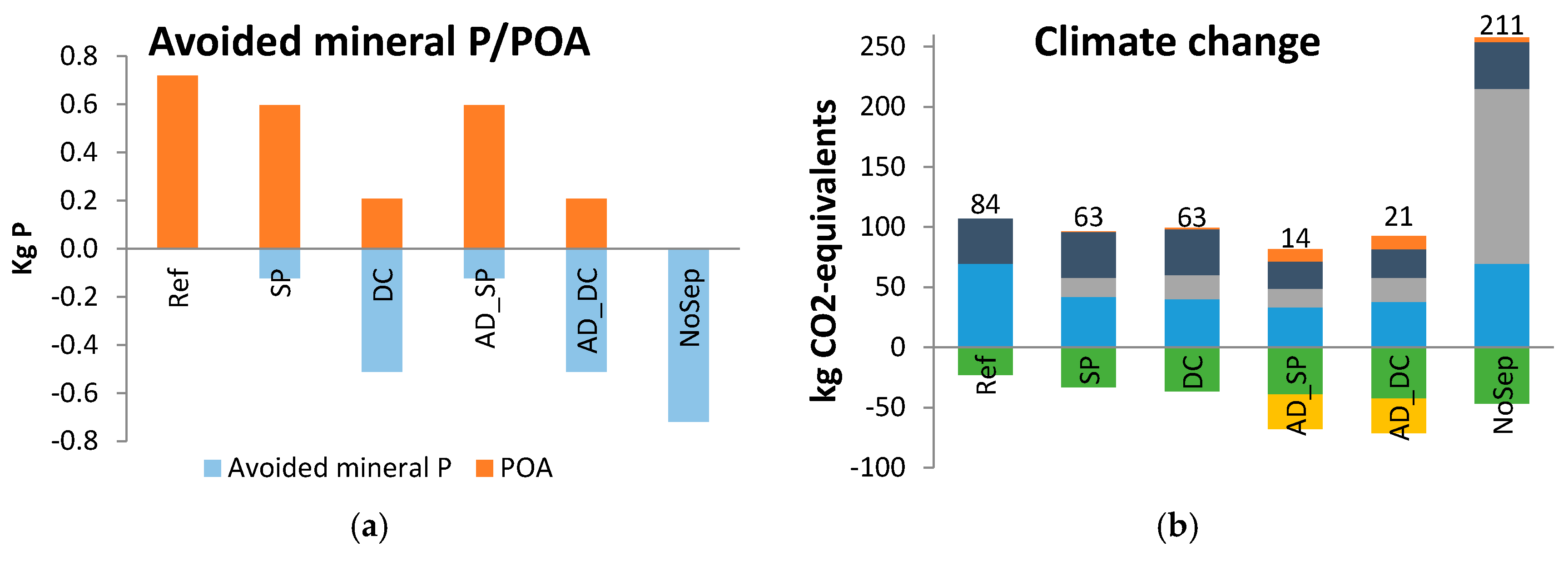
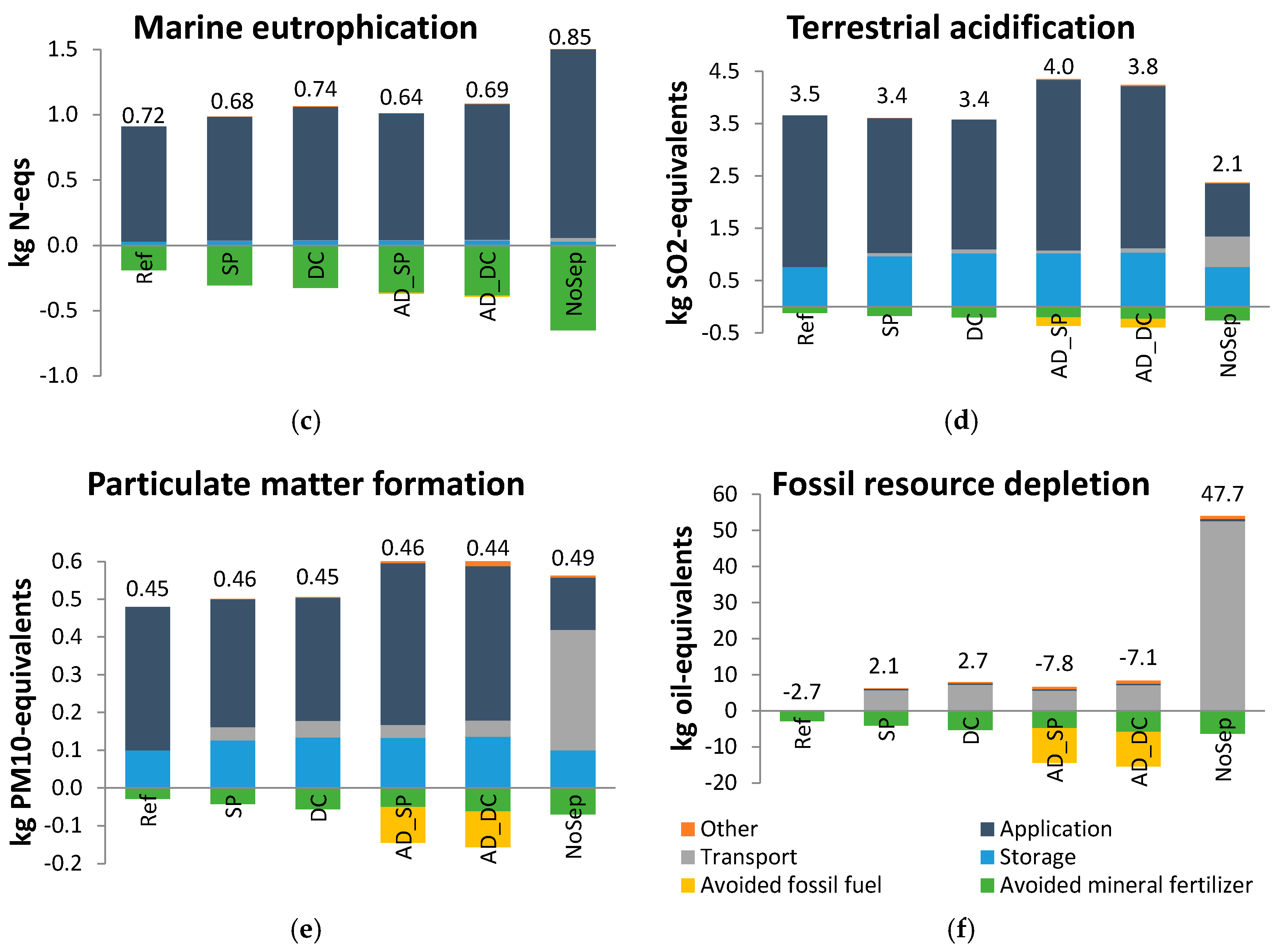
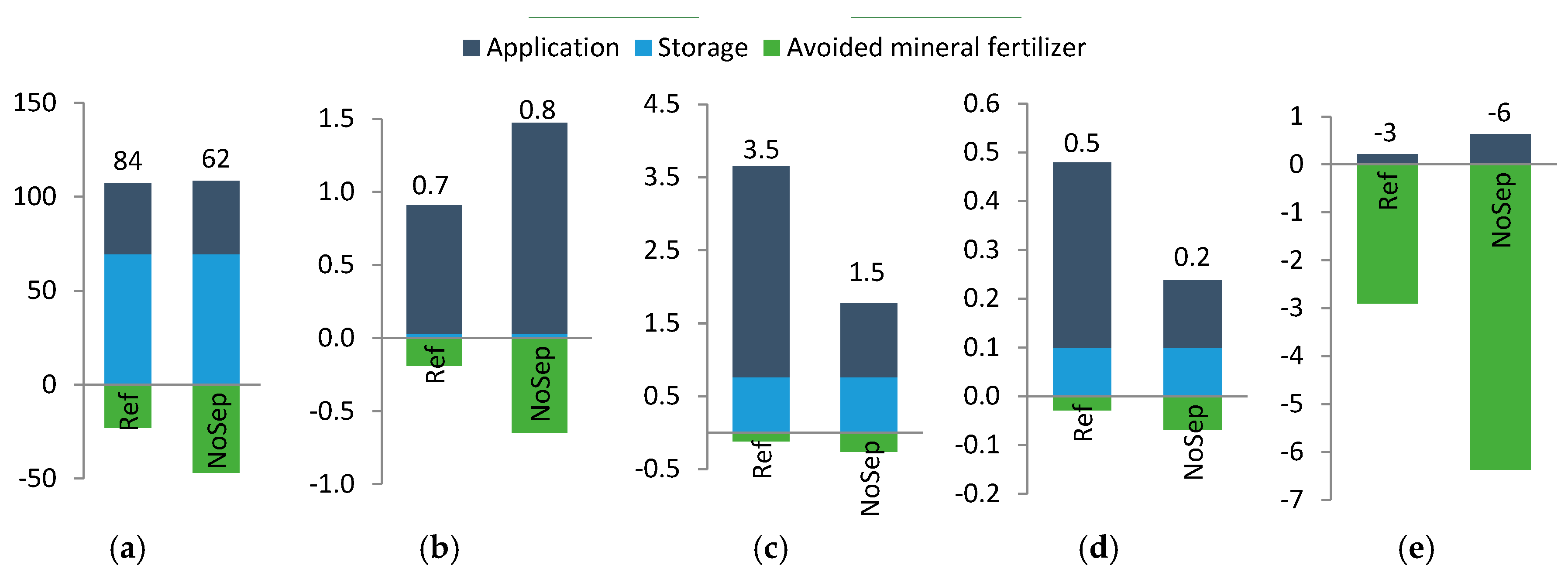
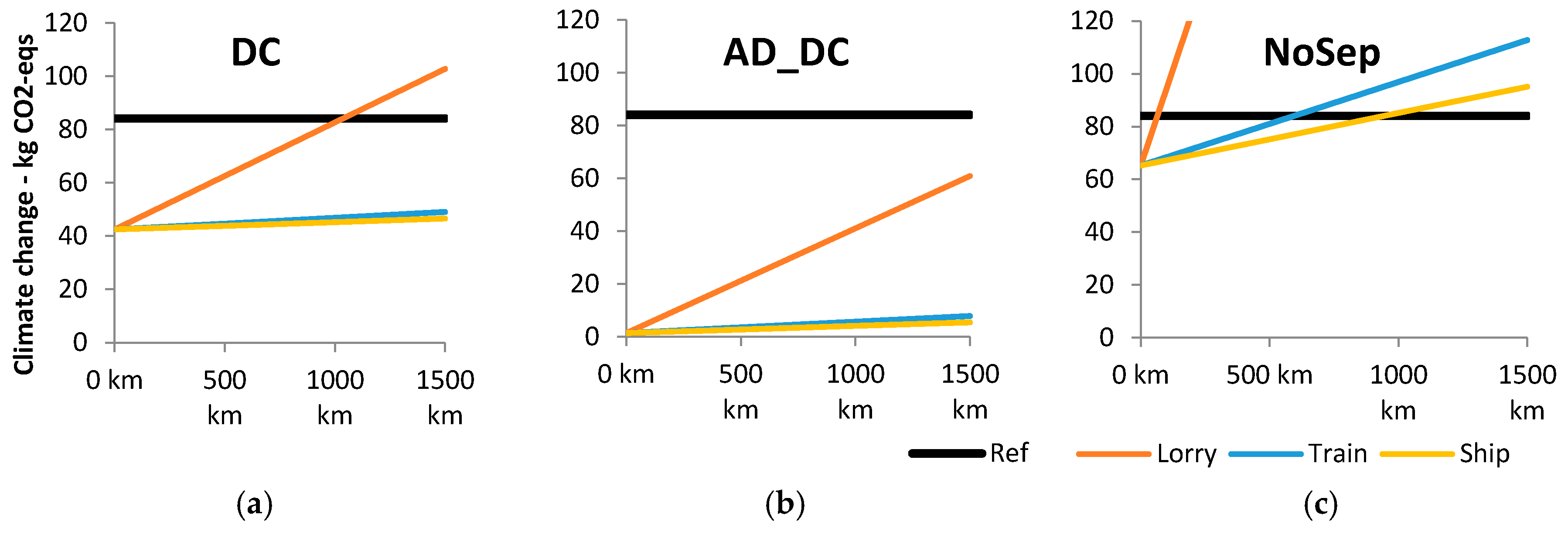
| Parameter | Donor Farm, Rogaland | Recipient Farm, Akershus |
|---|---|---|
| Soil P level | Very high | Moderately high |
| Main crop a | Grass | Cereals |
| Yield | 10,000 kg DM grass/ha; 3 cuts | 4000 kg DM spring wheat/ha |
| Fertilizer requirement b,c | 270 kg N, 0 kg P (30 kg P), 168 kg K per ha | 105 kg N, 10 kg P (14 kg P), 50 kg K per ha |
| Time of manure fertilizer application | 85% (80–90%) within growing season, 15% (10–20%) in autumn d | 100% in spring |
| Type of application | Liquid application with broadcast spreader, surface spreading in moderate weather conditions (sun and wind); mineral fertilizer: broadcast spreading | Solid fractions: solid manure spreader, incorporation within 3 h. Slurry: broadcast spreading, incorporation within 3 h; mineral fertilizer: broadcast spreading |
| Scenario | Stage/Manure Product | Mass | DM | OM | Tot-N | NH4-N | P | K |
|---|---|---|---|---|---|---|---|---|
| All | After animal | 1000 | 104.0 | 91.5 | 6.2 | 3.6 | 0.7 | 5.9 |
| Ref, NoSep | After in house storage—3 months | 1723 | 94.8 | 82.4 | 5.9 | 3.3 | 0.7 | 5.9 |
| SP, DC, AD_SP/DC | After in house storage—1 month | 1727 | 99.4 | 86.9 | 5.9 | 3.3 | 0.7 | 5.9 |
| After separation | ||||||||
| SP | Liquid | 1537 | 62.6 | 54.8 | 5.1 | 3.0 | 0.6 | 5.2 |
| Solid | 190 | 36.8 | 32.2 | 0.9 | 0.4 | 0.1 | 0.6 | |
| DC | Liquid | 1485 | 38.8 | 33.9 | 4.3 | 2.8 | 0.2 | 4.9 |
| Solid | 242 | 60.6 | 53.0 | 1.7 | 0.5 | 0.5 | 0.9 | |
| After AD of stored slurry | ||||||||
| AD_SP/DC | Digestate | 1698 | 69.9 | 57.4 | 5.9 | 4.2 | 0.7 | 5.9 |
| After separation following AD | ||||||||
| AD_SP | Liquid | 1511 | 44.0 | 36.2 | 5.1 | 3.8 | 0.6 | 5.2 |
| Solid | 187 | 25.9 | 21.3 | 0.9 | 0.5 | 0.1 | 0.6 | |
| AD_DC | Liquid | 1460 | 27.3 | 22.4 | 4.3 | 3.6 | 0.2 | 4.9 |
| Solid | 238 | 42.7 | 35.0 | 1.7 | 0.7 | 0.5 | 0.9 | |
| After end-product storage | ||||||||
| SP | Liquid | 1532 | 57.2 | 49.3 | 5.0 | 2.9 | 0.6 | 5.2 |
| Solid | 188 | 34.5 | 29.9 | 0.9 | 0.3 | 0.1 | 0.6 | |
| DC | Liquid | 1482 | 35.4 | 30.5 | 4.2 | 2.8 | 0.2 | 4.9 |
| Solid | 238 | 56.9 | 49.3 | 1.6 | 0.5 | 0.5 | 0.9 | |
| AD_SP | Liquid_dig | 1507 | 40.4 | 32.6 | 5.0 | 3.7 | 0.6 | 5.2 |
| Solid_dig | 185 | 24.4 | 19.8 | 0.9 | 0.4 | 0.1 | 0.6 | |
| AD_DC | Liquid_dig | 1458 | 25.0 | 20.2 | 4.2 | 3.5 | 0.2 | 4.9 |
| Solid_dig | 235 | 40.2 | 32.6 | 1.6 | 0.6 | 0.5 | 0.9 | |
| Emission Factor | Unit | In House Storage | End-Product Storage | Field Application | ||||||
|---|---|---|---|---|---|---|---|---|---|---|
| LF | SF | LFdig | SFdig | Slurry, LF, LFdig; Grass Land | SF, SFdig; Arable Land | Slurry; Arable Land | Mineral Fertilizer | |||
| NH3-N | % of NH4-N | 7 a | 1.7 d | 5 d | 1.7 d | 5 d | 29 h | 4 h | 10 h | 1% N i |
| N2O-N | % of tot-N | 0.1 b | 0.5 e | 2 e | 0.5 e | 2 e | 1.25 b/0.63 g | 1.25 b/0.63 g | 1.25 b | 1.25 b |
| NO3-N | % of tot-N | - | - | - | - | - | 12.8 j | 23.3 j | 23.3 j | 12.8/23.3 j |
| CH4-Clong | % of OM | 2 c | 0.4 f | 0.12 f | 0.06 g | 0.02 g | - | - | - | - |
| CH4-Cshort | % of OM | 0.35 c | - | - | - | - | - | - | - | - |
| MFE Nmin | % of NH4-N | - | - | - | - | - | 34.5/54 k,l | 65 k | 73 k | 100 |
| MFE Norg | % of Norg | - | - | - | - | - | 10.2 k | 10 k | 10 k | - |
| Separation Technology | Mass | DM | OM | Tot-N | NH4-N | P | K | Electricity Demand (kWh/ton) b |
|---|---|---|---|---|---|---|---|---|
| Screw press | 11 a | 37 a | 37 | 15 a | 11 | 17 a | 11 | 1.1 |
| Decanter centrifuge | 14 a | 61 a | 61 | 28 a | 16 a | 71 a | 16 | 4.3 |
| Parameter | Impact Category | ||||
|---|---|---|---|---|---|
| CC | ME | TA | PMF | FD | |
| Reference scenario | |||||
| DM content manure | 0.8 | - | - | - | - |
| OM share of DM in manure | 0.8 | - | - | - | - |
| Tot-N content manure | 0.3 | 1.0 | 0.3 | - | 0.3 |
| NH4-N content manure | −0.1 | - | 0.4 | 1.0 | 0.4 |
| P content manure | - | - | 0.5 | - | 0.3 |
| NH3 emission application on grass | - | 0.2 | - | 0.8 | - |
| NO3 emission application on grass | - | 1.1 | - | - | - |
| CH4 emission long storage manure cellar | 0.8 | - | - | - | - |
| AD_SP scenario | |||||
| DM content manure | −0.2 | - | - | −0.2 | 1.2 |
| OM share of DM in manure | 1.2 | - | −0.2 | −0.2 | −0.1 |
| Tot-N content manure | 1.3 | 1.1 | 0.4 | 0.4 | 0.3 |
| NH4-N content manure | −0.9 | −0.1 | 0.6 | 0.7 | 0.2 |
| P content manure | −0.2 | - | - | - | 0.1 |
| Amount of manure per cow | −0.4 | - | - | - | 0.3 |
| Amount of wash water per cow | 0.5 | - | - | - | −0.3 |
| NH3 emission application on grass | - | 0.2 | 0.8 | 0.9 | - |
| NO3 emission application on grass | 0.1 | 1.0 | - | - | - |
| NO3 emission application on arable land | - | 0.3 | - | - | - |
| Separation efficiency mass | 1.2 | - | - | - | −0.8 |
| Separation efficiency Tot-N | 0.4 | 0.1 | - | - | - |
© 2017 by the authors. Licensee MDPI, Basel, Switzerland. This article is an open access article distributed under the terms and conditions of the Creative Commons Attribution (CC BY) license (http://creativecommons.org/licenses/by/4.0/).
Share and Cite
Hanserud, O.S.; Lyng, K.-A.; Vries, J.W.D.; Øgaard, A.F.; Brattebø, H. Redistributing Phosphorus in Animal Manure from a Livestock-Intensive Region to an Arable Region: Exploration of Environmental Consequences. Sustainability 2017, 9, 595. https://doi.org/10.3390/su9040595
Hanserud OS, Lyng K-A, Vries JWD, Øgaard AF, Brattebø H. Redistributing Phosphorus in Animal Manure from a Livestock-Intensive Region to an Arable Region: Exploration of Environmental Consequences. Sustainability. 2017; 9(4):595. https://doi.org/10.3390/su9040595
Chicago/Turabian StyleHanserud, Ola Stedje, Kari-Anne Lyng, Jerke W. De Vries, Anne Falk Øgaard, and Helge Brattebø. 2017. "Redistributing Phosphorus in Animal Manure from a Livestock-Intensive Region to an Arable Region: Exploration of Environmental Consequences" Sustainability 9, no. 4: 595. https://doi.org/10.3390/su9040595
APA StyleHanserud, O. S., Lyng, K.-A., Vries, J. W. D., Øgaard, A. F., & Brattebø, H. (2017). Redistributing Phosphorus in Animal Manure from a Livestock-Intensive Region to an Arable Region: Exploration of Environmental Consequences. Sustainability, 9(4), 595. https://doi.org/10.3390/su9040595





